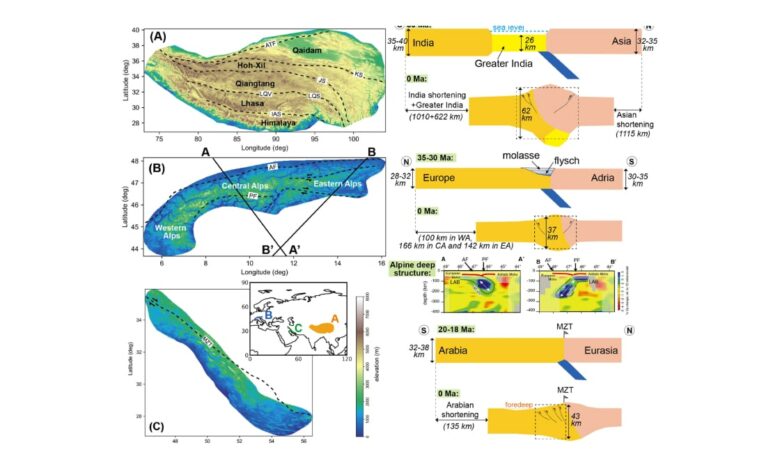Formation of the Himalayas could have destroyed 30 percent of the continental crust

In a study published in Earth and Planetary Science Letters, researchers quantified the significant loss of continental crust to the mantle during the formation of major mountain ranges, including the Himalayan-Tibetan Plateau. Dr. Ziyi Zhu, a Research Fellow at Monash University, together with colleagues conducted an analysis of the dynamics of the Earth’s crust, which showed that up to 30% of the crust may have been destroyed in collision zones, with implications for the Earth’s geological evolution. The findings were compared to other mountain systems such as the European Alps and the Zagros Mountains.
Massive loss of the Earth’s crust during collisions
According to the studythe team developed a mass and volume balance model to measure the amount of continental crust that underwent subduction or delamination during collisions. By assessing the thickening, lateral extrusion, and erosion of the crust, an imbalance was identified, indicating that a significant portion of the crust had sunk into the mantle. Dr. Zhu told Phys.org that this process can be compared to the compression of soft material, in which displaced parts disappear beneath the surface instead of being preserved at ground level.
Mechanisms behind Crustal recycling
The study highlighted that delamination is the main mechanism driving crustal recycling, especially during the formation of the Himalayan-Tibetan Plateau. This process, characterized by the sinking of denser lithospheric material, was linked to the creation of specific rock types with geochemical markers indicating mantle influence. Evidence also linked these events to the rapid rise of the Himalayas and subsequent climate changes, including intensified monsoon rains some 22 million years ago.
Implications for mountain systems
Similar processes have been reported in other regions, such as the European Alps and the Zagros Mountains. Nearly 50% of the crustal volume of the Alps and up to 64% of the crust of the Zagros Mountains were lost during their respective formation periods. The research suggests that such losses have occurred throughout Earth’s history and have affected the composition of the mantle for billions of years.
This research highlights the interplay between processes in the deep Earth and changes at the surface, providing insight into how crustal dynamics shape the planet.
For the latest tech news and reviews, follow Gadgets 360 X, Facebook, WhatsApp, Wires And Google News. For the latest videos on gadgets and technology, subscribe to our YouTube channel. If you want to know everything about top influencers, follow our in-house Who is that360 on Instagram And YouTube.

Competition Commission of India will investigate Google’s strict policy on real money gaming apps
New Google Photos Design for iOS Removes ‘Memories’ and Adds ‘Moments’ Tab to Collections





